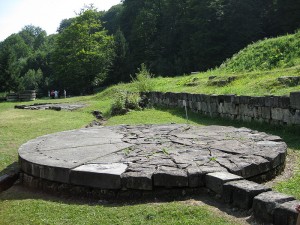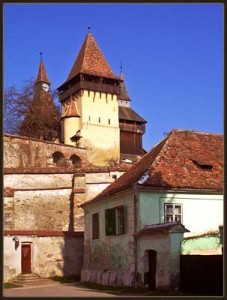Romanian sights included in the UNESCO World Heritage list

Romania has seven cultural and natural objectives included in UNESCO's World Heritage list.
 1. The Danube Delta has entered the UNESCO list in 1991. The Danube Delta is the second largest and the best preserves delta in Europe. The Danube Delta is a wildlife enthusiast’s (especially a bird watcher’s) paradise. It hosts the highest concentration of bird colonies in Europe. The maze of canals bordered by thatch, willows and oaks entangled in lianas, offers the perfect breeding ground for countless species of birds, some of them from as far away as China and Africa. There are 300 species of birds in the Delta in total. The Delta can be explored as part of a Danube River Cruise, or on day trips and boat excursions from Tulcea. The Danube Delta was formed over a period of more than 10,000 years and it continues to grow. It is also the youngest piece of land in Romania. The Delta is formed around the three main channels of the Danube, named after their respective ports: Chilia (in the north), Sulina (in the middle), and Sfantu Gheorghe (in the south).
1. The Danube Delta has entered the UNESCO list in 1991. The Danube Delta is the second largest and the best preserves delta in Europe. The Danube Delta is a wildlife enthusiast’s (especially a bird watcher’s) paradise. It hosts the highest concentration of bird colonies in Europe. The maze of canals bordered by thatch, willows and oaks entangled in lianas, offers the perfect breeding ground for countless species of birds, some of them from as far away as China and Africa. There are 300 species of birds in the Delta in total. The Delta can be explored as part of a Danube River Cruise, or on day trips and boat excursions from Tulcea. The Danube Delta was formed over a period of more than 10,000 years and it continues to grow. It is also the youngest piece of land in Romania. The Delta is formed around the three main channels of the Danube, named after their respective ports: Chilia (in the north), Sulina (in the middle), and Sfantu Gheorghe (in the south).
The Danube Delta Biosphere Reserve has the third largest biodiversity in the world (over 5,500 flora and fauna species), exceeded only by the Great Barrier Reef in Australia and the Galapagos Archipelago in Ecuador. More then half of the Delta Biosphere Reserve is virtually intact. Some 15,000 people inhabit the Delta area, living in 28 villages and one city (Sulina), which is the easternmost point of Romania. The area was first attested by Herodot of Halicarnas (484 – 425 B.C.).
Read more about places to see and accommodation in the Danube Delta here.
2. The Moldavian Churches were included on the World Heritage list in 1993. The list includes The ''Taierea Capului Sfantului Ioan Botezatorul'' church from Arbore village, The ''Adormirea

Maicii Domnului si Sfantul Gheorghe'' church of Humor Monastery, The ''Buna Vestire'' church of Moldovita Monastery, The ''Sfanta Cruce'' church from Patrauti, The ''Sfantul Nicolae'' church of Probota Monastery, The ''Sfantul Gheorghe'' church from Suceava, The ''Sfantul Gheorghe'' church of Voronet Monastery.
A map of several Moldavian monasteries here.
3. The Hurezu Monastery was also included in UNESCO's World Heritage patrimony in 1993. The monastery is located south of Romania, 27 miles east of Ramnicu Valcea. Founded in 1690 by Prince Constantine Brancoveanu, the monastery of Horezu is a masterpiece of the 'Brancovenesc' style. The monastery museum, housed in the princely residence, features masterpieces of Brancovenesti art: icons, books, embroideries, silver collections and an interesting library of old books containing approximately 4,000 volumes. Overnight accommodation available.
4. The villages with fortified churches in Transylvania were included in the UNESCO patrimony in 1999. These include the following: Calnic, Prejmer, Viscri, Darjiu, Saschiz, Biertan,Valea Viilor. Transylvania is home to nearly two hundred villages with fortified churches built by the Saxons between the 13th and 15th centuries. These are close to Sibiu, Sighisoara, Brasov.

5. The Dacian fortresses in the Orastie mountains are a World Heritage objective since 1999. These include Sarmizegetusa Regia -Gradistea de Munte, Costesti Cetatuia, Costesti Blidaru, Luncani-Piatra Rosie, Banita, Capalna.

Sarmisegetuza Regia was the capital of the Dacian state before the Roman invasion. The ruins of the fortress are located in Hunedoara county. This is the biggest of the Dacian fortresses and was the core of the Dacian defensive system, which included six fortresses. Here you will see, among others, the Circular Calendar , one of the most important Dacian circular sanctuaries. The Dacian capital saw its peak years under king Decebal, who was defeated by the Roman Empire during emperor Traian.
6. The Wooden Churches of Maramures, part of the UNESCO World Heritage since 1999, include The church ''Intrarea in Biserica a Maicii Domnului'' (Barsana), The church ''Sfantul Nicolae'' (Budesti), The church ''Sfanta Paraschiva'' (Desesti), The church ''Nasterea Maicii Domnului'' (Ieud-Deal), The church ''Sfantul Arhanghel'' (Plopis), The church ''Sfanta Paraschiva'' (Poienile Izei), The church Sfantul Arhanghel'' (Rogoz), The church ''Sfantul Arhanghel'' (Surdesti)
7. The historical center of Sighisoara, part of the UNESCO patrimony since 1999, was founded by German craftsmen and merchants known as the Saxons of

Transylvania. Among the attractions in the city are the 210-feet high Clock Tower (Council Tower), built in the 14th century, and the fortified walls, built in the 14th and 15th centuries. Sighisoara was the European Cultural Capital in 2007.
The World Heritage list includes 890 properties forming part of the cultural and natural heritage which the World Heritage Committee considers as having outstanding universal value.
Here is the complete list of World Heritage properties in the world.












